Zoltán Kodály: Psalmus Hungaricus
9 May 2010, Italian Cultural Institute, Budapest
Tamás Cselóczki
Tenor
Budapest Academic Choral Society
Chorus master: Ildikó Balassa
Budafok Dohnányi Orchestra
Good afternoon, Ladies and Gentlemen. Warmly welcome to everyone here in our concert today. This day presents a very special occasion: partly because (as I’ve devoted this whole year’s series to my teachers and professors) with this closing concert I wish to pay obeisance to Imre Földes [1], which can thus be considered a symbolic event. Probably he is the most “responsible” for my maniac desire to persuade my audience to comprehend, understand and love music. So first of all let me welcome Professor Földes here with all my heart.
But this day is extraordinary also because in addition to our current members in Budapest Academic Choral Society our former singers will also perform in this concert, considering that we’ve been singing together for exactly 30 years now.
I had two reasons for choosing Psalmus Hungaricus. The first is that we’ve sung it with the choir a lot of times ever since the beginning and performing this piece has always contributed to a ceremonial moment in our life. The other reason is that (I’ve really checked it) it was exactly 30 years ago when Professor Földes held an unforgettable lecture about Psalmus Hungaricus in the Academy of Music. I think I can remember his lecture: it was then and there, in the Music Academy lecture that I collected my current apprehension of this work and learnt everything I believe and think about it. But of course all this will turn out now – at least certainly for Professor Földes.
We’ve distributed a sheet among You, and even if You don’t all read music, You’ll see that relying on this staff You’ll get somewhat closer to a certain miracle hidden in the leading melody of Psalmus.
Among others, there’s a very important thing we’ve learnt from the Professor, and this strictly echoes in my ears in almost each moment of my life. Namely that we musicians must understand why each note is what it is and not something else. This quest for actual answers flashed a beam of light on my understanding that we can take in music subject to the relation between our expectations and the fulfilment of our expectations. For those who listen to music the delight in and joy of music will primarily be materialized in the fulfilment of their expectations, which can simply be called recognition.
For incitement I’ll now reveal You that all in all the joy of listening to music still originates from extraordinariness and suddenness, provided our endmost feeling is indeed the fulfilment of expectations and the enjoyment of recognition. I can reassure You that You similarly like the very compositions and find them the most exciting wherein the composer frequently “cheats” You relevant to Your expectations. We musicians also learn by first understanding the rules through less determinative masters or small pieces, and later when we meet the great masters, we try to learn the miracle from them, i.e. to identify what we expected, what we got instead and why. We musicians are capable, with some luck, of phrasing the answer for ourselves, but You can also often feel some suspicious or strange in Your innards. After all, this is one of the most essential parts of listening to music. Psalmus Hungaricus, the piece we’ll introduce now, is unique in this regard.
Let’s now sing the “Psalmus melody”, which is in fact considered a piece of perfection engraved in stone.
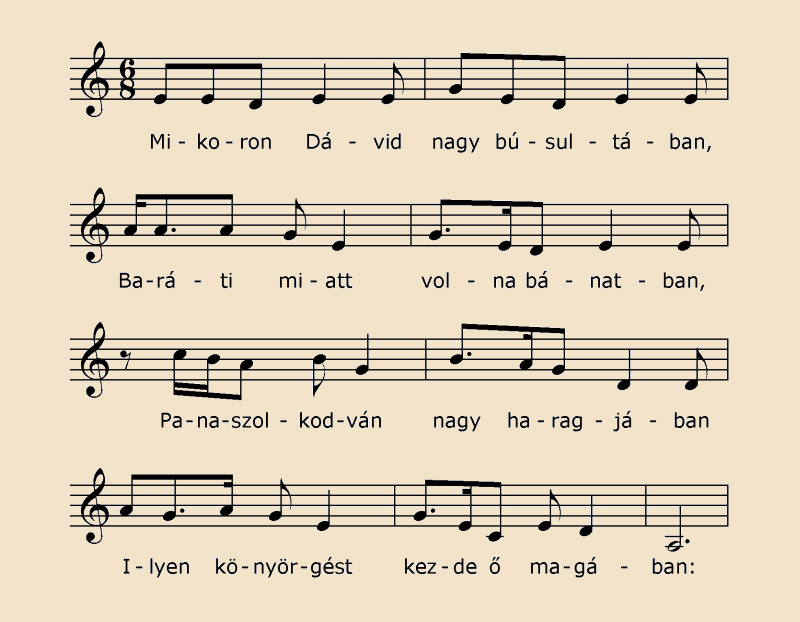
Rightly we feel this is one of Kodály’s most miraculous melodies, a kind of revelation that can sound only as it is and no other way. It’s a gracious melody for us as we can identify ourselves with it, given that it’s sensible Hungarian music. But why? Because, as You’ll see, it has a typically Hungarian melody and structure; and just like each Hungarian folk song, this also has a four-line structure.
Let’s now have a look at the first line.

If You consider not only the bar lines but the other dotted vertical lines, too, You’ll see that the first row of the theme is divided into four elements. This division might seem rather strange in the text but it’s reasonable from a musical point of view. If we wanted to give a name to these four elements, the correct formula could be AABA, considering that the 1st, 2nd and 4th elements are very similar, whereas the 3rd is considerably different. What’s more, don’t forget that the 2nd and 4th elements are wholly identical.
In the very first moment the central point of the melody essentially seems to be a single sound, an E tone on the bottom-most horizontal line, as it sounds twice equally in the 1st, 2nd and 4th elements. The 3rd element differs significantly: although here we similarly have an E tone but there’s no repetition in tones, there are three different tones. Furthermore, the first G tone considerably outstands from the central tone, it’s higher in pitch. This outstanding tone expresses the essence of the text: “in great grieve”.
Now let’s see a bigger part of the melody, the first and second rows together.
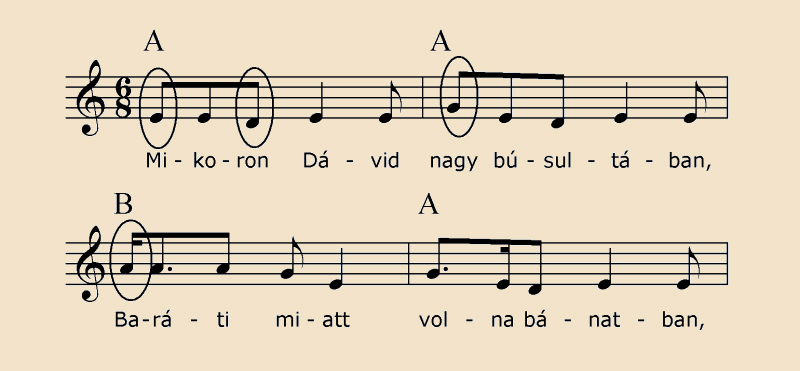
If we consider this melody from a somewhat remote distance and examine the first two rows together, we’ll see that (how strange!) this longer melody can likewise be divided into four parts, and each meter can be considered a part on its own. What seemed to be a difference from the nearby will smooth out into resemblance from a distance, so the first and second meters can essentially be taken as identical. Still, using this division, we find the third tact discordant. Why? Because a fourth, new sound, the A tone is sung, and on top of it all, three times one after the other, which exceedingly highlights the importance of the meter. And then the fourth meter (well, who would’ve thought so) is in full concord with the second. This means that if we analyze the first two rows of the theme as a single unit, it will similarly have an AABA structure where the 2nd and 4th elements are wholly identical.
So our expectations will apply from this very moment on. Whether we know or not, whether we understand or not, this experience creates a certain kind of expectation. If we live through something twice, it will next appear as an expectation.
The developments in the continuation are very interesting. We’ve so far heard four tones that can adapt to the tonality typical in the somewhat ancient layers of Hungarian folk music, to pentatony [2]. Pentatony, i.e. the five-tone scale is uniquely our music here in Europe, a Hungarian peculiarity. By the way, it’s also typical of Chinese music, which though doesn’t really bother us, yet is most probably not a coincidence… But of course we can also play with the idea that we, you see, could do with five notes for centuries, or the other tones didn’t simply get to us.
Going back to the first two rows of Psalmus: we feel this is genuinely our five-tone scale because the leading melody in the first two rows perfectly fits in the pentatonic system. How many tones have we heard so far? Well, actually four: D, E, G, A. How did the new tones appear after the first two tones (D, E)? They started the 3rd element of the quadripartite divisions.
What do we expect then? Don’t You think that, following the above pattern, we could consider these first two rows the first two lines of a major structure? Let’s have a look at them: are these two rows really so different? Not so much, from a distance. So then if these are the first two rows, what kind of third row do we expect? It will definitely differ from the previous ones, and first of all there’ll be a new tone in it. But actually we have one more tone left, the fifth tone if we stay within the frames of pentatony. That’s true, still, two kinds of fifth tones can present the solution. A scale can be built on any and each of the five tones of pentatony, which means that any of the five tones can start or close a scale. Given these four tones now, there can only be two closing tones, provided the E tone which closes both rows is sung as a “la” or “mi” solfa syllable. If it’s a “mi”, the missing fifth note will be “do”, i.e. C tone. If it’s considered a “la”, the missing fifth tone will be “mi”, i.e. H tone. So based on what we’ve heard so far, either of these two fifth tones will have to sound now.
Let’s see what happens. Let’s have a look at the third row.
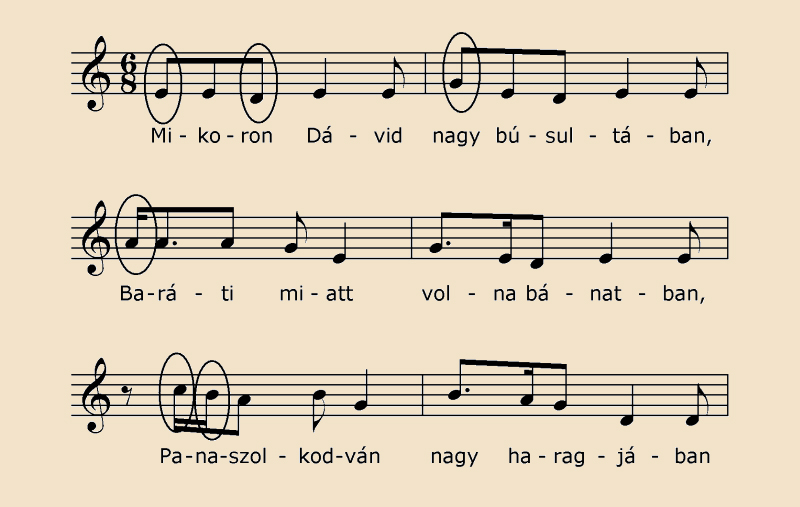
What does it begin with? Wow! A rest. This rest can have a lot of meanings. Perhaps Kodály wants to excite our expectations. Perhaps it suggests that the part after the rest has a special significance. And this is it: both fifth tones are used after the rest, so our puzzle comes to full completion. First we could be inclined to favouring the C tone which sounds first, considering that we’ve so far felt the first appearance the most emphatic. That’s true, but then the composer repeats H in the most weighty moment of the second meter in the third row. No bigger falsehood could be opposed with our expectations. Here we are thwarted and have no clue as to what key we are in. Be that as it may, the fourth row must come now, and this (as always so far) must definitely coincide with the second row. Let’s sing the melody according to the above expectations, so the second row should coincide with the fourth row.
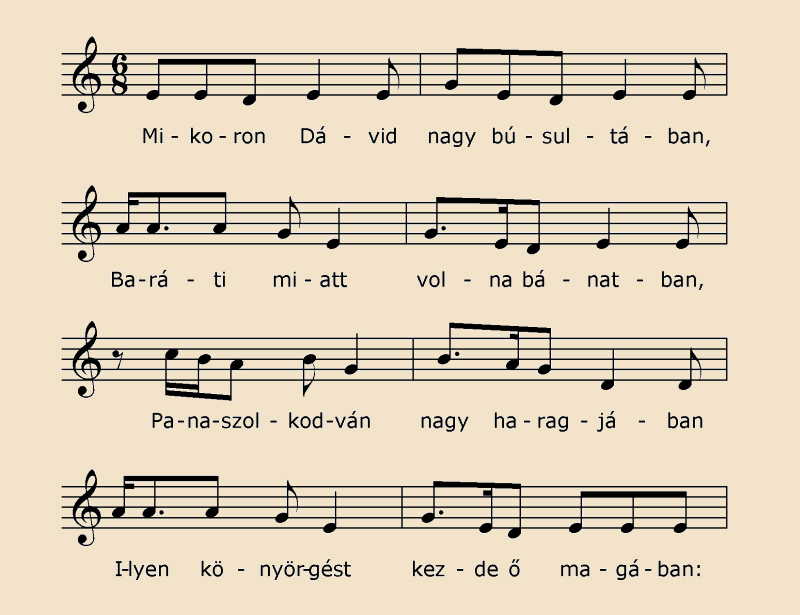
Whether You believe or not, this is the correct answer. This is how it should be or, to be more precise, this would meet our expectations. But did Kodály make a mistake? No. Deliberately he added a different ending to the melody. Partly because the closing tone is one fifth [3] lower, which recalls the ancient descending nature of Hungarian folk music. Moreover, the last tone leaves the former structure and opens the door to the ideology of the whole piece.
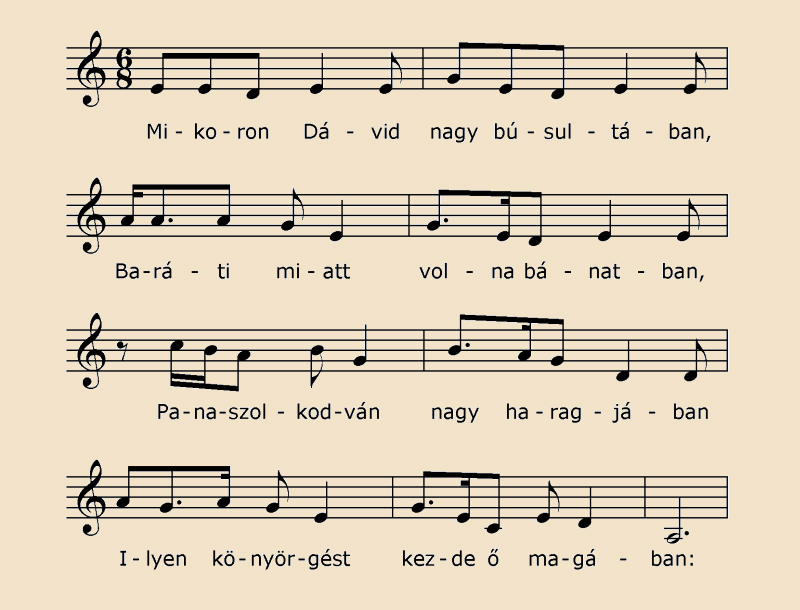
Regarding the leading melody of the masterpiece which moves from anguish through despair to hope Kodály looks for an ending that can shock the listener. As You’ll see, this ending is certainly not by mere chance. Kodály knew very well why he composed so and not some other way that would have satisfied our expectations. But here and now I dare disclose that this “correct” ending will sound once in the piece…
Dear Ladies and Gentlemen, Perhaps the above words could already reveal that Psalmus Hungaricus is an exceptionally exciting piece. After all that excitement with the leading theme Kodály composed a strict structured, well-arranged and easy-to-follow dramaturgical process. The masterpiece is composed for tenor solo, mixed choir and orchestra. The tenorist plays a narrative role, a frequent role in oratorios: whereas this is King David’s psalm, he represents the anguished king himself who expresses his grievance, in first person singular.
Kodály used the translation (made between 1561 and 1567 by an almost wholly unknown Hungarian preacher and poet Mihály Kecskeméti Vég [4] from the 16th century) of a psalm in Psalmus. (Actually, this is the only poem that survived from the otherwise unknown poet.) A great number of translations were made of the psalm in the age of reformation, still, touchingly, some personal thoughts also infiltrate into this translation of the 55th psalm and petition, written in heart-sore, grief and sorrow, and this makes it a real Hungarian psalm.
Unfortunately, this psalm is still a kind of summary of us Hungarians. A mirror of our life, heart-sore, our bad and good relations with one another.
Kodály wrote Psalmus Hungaricus on the occasion of the 50th anniversary of the unification of Pest and Buda. Let me note here that several other compositions were similarly made for this anniversary in 1923, for instance Bartók’s Dance Suite [Táncszvit] and Dohnányi’s Ceremonial Overture [Ünnepi nyitány]. But in Psalmus, in place of the expected jubilation, Kodály extends honest, deep and elementary dimensions. What makes this composition even more specific is that the Hungarian nation began to understand its own music at this time, it began to make acquaintance with its own cultural and musical identity and this is when the linked logics of Hungarian folk music and European music evolved into an unbreakable, wholly uniform and natural for all process.
Psalmus is a genuine romantic work. It uses the tools of romanticism in all its elements, from naïve modulations to weighty and dramatic contrapositions. Right in the very beginning it starts like furious. No musical composition would have such a beginning. Just keep Your ears open to the starting moments when we feel as if we were jabbed with a dagger.
As early as in the introduction Psalmus reaches one of its highest peaks. We immediately understand that it will be about life and death, since our composer immediately initiates us into the most serious drama. Then we hear the miraculous leading theme which doesn’t really seem to take part in the entire musical process; it appears to be not a part but a quasi frame of the work. We hear it several times as a small recurring musical unit, a so-called ritornello.
Later on this evolves into a process of wondrous power ranging from psalm obsecration through bitterness to curse.
Here we hear something that’s been the tool of naïve madrigalism [5] for centuries and that can the most typically express grief.
This arch of melody is called a “crying motif” or moan. Just listen how many dozens of times we hear it in the piece. And then of course, after the orchestra, this gesture of two adjacent half-tones will also be sounded by the singer and in the various parts of the choir. This is real tremendous anguish. There’s a lot of infantile simplicity in it, yet concurrently it’s immensely impressive. Sadly enough, this motif slightly characterises our national history, it even appears in the culmination of our Anthem (“Atoning sorrow hath weighed down All the sins of all his days”).
This is then again followed by simple sound-painting. Pay attention to what’s happening in the orchestra.
What does this orchestral play symbolize? A twirl within itself. Then the tenorist sings “Nightly and daily go they about me, Seeking how they may take me in the snare”. The now well-known crying motif almost shouts as it breaks the twirling motif: this part is actually weeping, almost lamentation; the psalmist (King David) gets into a more and more unsettled emotional mood.
We, the listeners also got in a scary emotional state. But this will still intensify: the choir enters and they also accompany the psalmist’s immense gust with a mighty and common cry. Still, we’re not yet at the real zenith. The real zenith is curse. We all know very well that for the professed man the curse he utters himself is impossible. A Christian must not accurse anyone. Yet art in its own soaring is always trivially humane. And we, humans curse each other (at least allegorically) rather frequently and, unfortunately, more often than required. What’s more, the gesture of profanity can truly be found in highly pious works. A poet must inevitably show the antagonisms that would not exist in us, humans without one another. Actually, religion doesn’t exist without irreligion, love without curse or glorification without profanity.
So then the piece reaches its zenith when the psalmist cries out: “Smite them with destruction, O Lord, and slay them”. Actually, nowadays we also say so with some other ruder words and, unfortunately, rather frequently. Kodály phrases this curse with soul-stirring elementarity.
Take note of the contraposition. This is what the psalmist sings: “But it was thou, my friend whom I trusted, Did we not take sweet counsel together? Thou whom I reckon’d true friend and faithful Thou art the man whose hand would have struck me down!”. This is how he confronts the benignant and kind friend who in fact was an enemy. Some say if we utter the curse, we’ll ease up. We have no other choice but faith, confidence and hope. The psalmist’s farewell is in fact exactly about this: miraculously, now he already sings about love, hope, turning to the Lord and even turning to men.
Let’s listen to the delightful end of the aria. Kodály uses miraculous orchestral sounds to develop the mood. The harp plays an important role, as King David’s harp must be sounded in this piece. In addition to the harp, a violin solo plays the leading role here. The violin solo represents a typical Kodály-style character: in his orchestral pieces Kodály always composes the overflowing emotions for a violin solo, whereas in his choral works they appear in a soprano solo.
The psalmist’s last sound brings about wondrous relief. From here on Kodály doesn’t give any more role to the soloist in this work.
Let’s now on turn our attention to the choir. The choir has so far seemed to have a subordinated role. We’ve heard them very rarely, they crossed the psalmist’s song with the leading melody. After hearing the leading melody, we hear it one fifth higher, in the higher voices, reacting to the psalmist’s intense emotional mood.
Then getting higher and higher in this circle of fifths [6] and following a major augmentation the choir sings in really triumphal height.
How strange! The choir didn’t finish where it should’ve finished. Kodály can miraculously demonstrate that you cannot simply finish singing in such an emotional mood, so he also composes the process of satisfaction. We start and feel that the choir has a really important role when it follows the soloist in mentioning the words “belief” and “hope”. “I give Thee honour, Lord, and worship Thee, Evening and morning and at the noonday, Thou that abidest, Thou art my helper When those that hate Thee sorely do oppress me.” This represents the first occasion for the choir to become a partaker in the dramaturgy of the piece, though true, not on its own but as the soloist’s echo.
After the psalmist’s beautiful aria the choir is left alone, thereby expressing that the community has understood the psalmist’s words and is now capable itself of continuing these thoughts. Just as in so many pieces, here again a core element in the dramaturgy of the work is relationship between individual and community, the chosen and the mass, men’s loneliness and their disengagement in the community.
Getting to the closing part of the piece, Kodály is exceedingly lively, yet fascinating as he moulds the biggest lesson into sounds from the lips of the choir: “Thou art our One God, righteous in judgment, Vengeance is Thine for those that do evil, Thou shalt not bless them, trusting in vain things, Thou shalt take them away as with a whirlwind”. The first word is again devoted to curse, as a peculiar phenomenon in human nature is that it expects the Lord to destroy its own enemies and first it thanks for this.
“As for the righteous, Thou dost preserve them, They that shew mercy shelter find in Thee. Those that are humble Thou dost raise on high Those that are mighty scatter’st and destroyest. Whom for a space Thy wrath has chastised, And has like silver tried in the furnace, Forth from the fire Thou suddenly tak’st him,…” The text is wonderful and especially exciting is the musical process here. Kodály devotes a stand-alone musical gesture to each thought. Just take notice of the warmth as the choir sings about the righteous, the cosseting melody the composer designs to address the merciful, the incredible strength he exerts in hoping to elevate the humble and the almost devastating blow whereby he “destroyest” the mighty. And then he needs a single run to help us flee from the almost burning fire of the orchestra. Delight in this exquisite beauty.
But then something happens and reasons why I spent so much time at the beginning of our concert today on explaining the structure of the leading theme to You. If You can still remember, I tried to show You a certain ending of this melody that would meet our expectations, that Kodály chose to replace with something else and that has by now become a quasi natural ending for us all. Sensibly, Kodály invests special efforts in closing this succeeding section and expressing a thought that can accomplish the previous rows: “Forth from the fire Thou suddenly tak’st him, Once more in honour Thou wilt raise him on high!”. The composer phrases these words in the last two rows of the leading melody and closes them just as he closed the leading theme in the beginning of Psalmus.
As we’ve heard this melody with this ending several times in the piece, we expect to hear it now again, this would meet our expectations. But Kodály takes off once more and, lo and behold, just once he after all shows the “correct” ending which would’ve been the expected ending when we heard the piece for the first time.
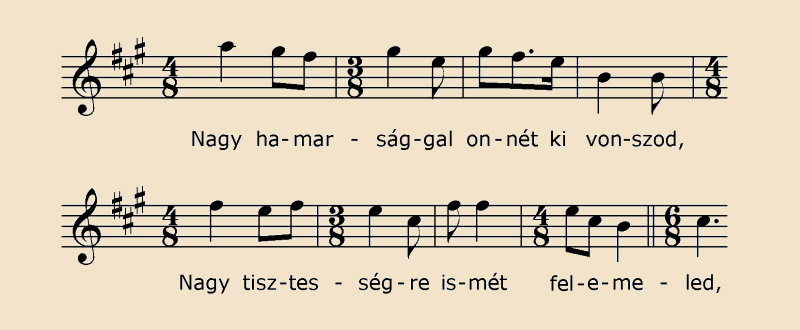
An indeed marvellous zenith that takes us up right to the sky is created with this “correct” ending – but now we’ll show it to You not with the choir but the orchestra. We seem to have the impression that such a romantic hearted composer as Kodály must’ve composed Psalmus for this very zenith. Listen to this gloriously sounding, poignant triumph, the heart-stirring and joyful hullabaloo of the trumpets, the timpano and the entire orchestra.
But then there’s a loophole and evidently the triumph doesn’t last forever: the key turns from major to minor, from the glorious height we fall back again to the deep. Even if there was some rejoicement, it was a mere dream that has dissolved; we’ve got back to where we’ve started from. What will follow now? Nothing else but what this masterpiece began with. Now again we can listen to the psalm song. The big question is how Kodály would close it this time. Can the so far once heard ending which brought about triumph and which I called “correct” still return, or will the leading melody logically end just like in its first appearance? The latter seems to be odds-on, given that the dream has dissolved, the belief whereby the Lord elevates the righteous exists in our hopes only but, unfortunately, not in the actual present. And just as expected, the melody will indeed end as heard for the first time: with the feeling of renouncement.
But then, almost beyond the ending, the tenor part sings the ending that materializes the zenith – very soft, from a distance, as a message from eternity. The two different closing tones of these two different farewells sound concurrently and so close the entire piece, and we, the audience can decide, relying on our feelings and thoughts, what catharsis we will reach by the end of Psalmus Hungaricus.
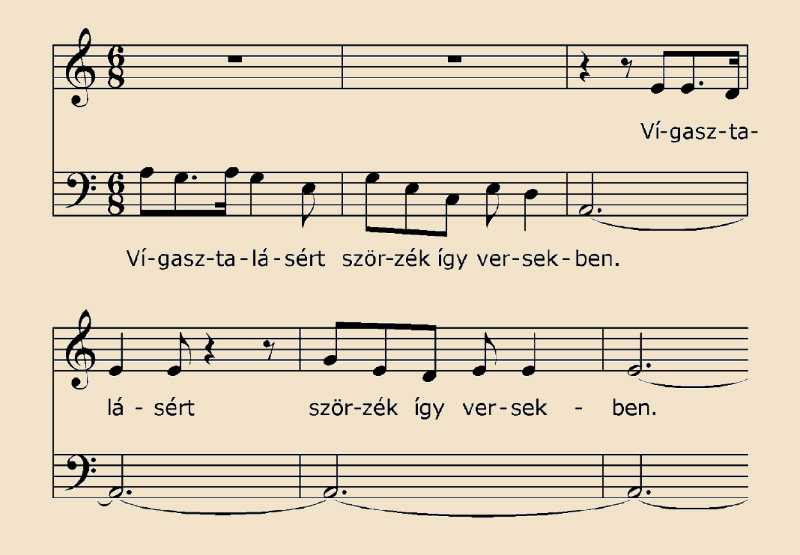
In Psalmus Hungaricus Kodály melodised eternal thoughts and irresolvable antagonism, and for this he consciously used our own Hungarian musical ideology, our existing or at least anticipated expectations. I’m afraid Hungarian folk music, the elementary recognition of its elements might be a bit distant for us; this language is not so much ours as we’d prefer, still, we understand and feel our musical mother tongue expressed by Kodály.
All these thoughts reveal an eternal message and eternal lesson. We may all decide which specific tone we hear last and which tone we’re ready to build our life on. I think this is the message I can be grateful for to Professor Földes and I hope I managed to transfer this message to You, too.
So let’s listen to the ending and then the entire piece.
________________________
[1] Imre Földes (1934): music historian, musicologist. A key personality in Gábor Hollerung’s work and mentality.
[2] Pentatony: a five-tone scale which does not yet use two typical sounds from the later European musical system, the half-tones, i.e. the „fa” and „ti” solmization notes.
[3] Fifth: five-tone interval.
[4] Mihály Kecskeméti Vég: 16th century protestant songwriter. No accurate information is available of his life. His 54th (55th, according to Vulgata) psalm overtops the psalm translations of that era: he conveys the original words in powerful images, in poetic picturesque style.
[5] Madrigalism: a name originating from the word-painting technique used in madrigals, when music expresses the sense of not a whole sentence but the words one by one.
[6] The circle of fifths depicts the 12 columns of superordinated and finally reverting fifths in a single circle. Consequently, the circle of fifths shows the key signatures in their logical sequence. Progressing upwards, i.e. in the direction of the (#) sharp keys in the circle of fifths means a kind of elevation, whereas descending downwards to the direction of the flat keys calls forth the feeling of some downfall.
Translated by Helga Párkai

